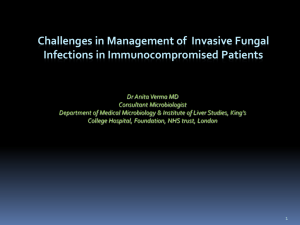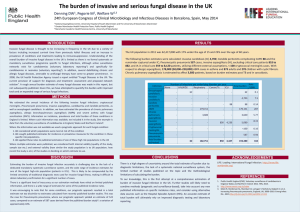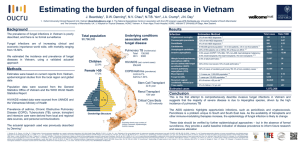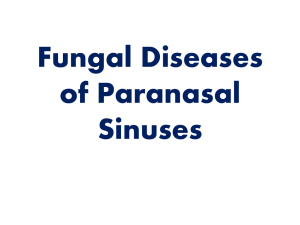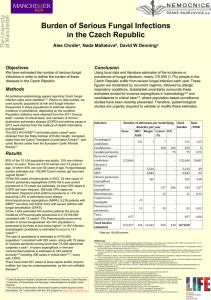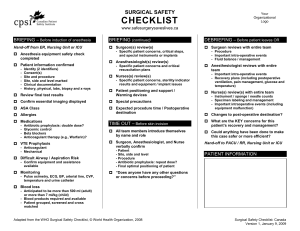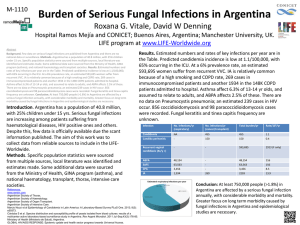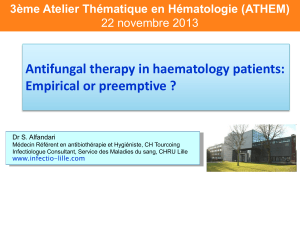Investigation and Management of Invasive Fungal Infections in
advertisement
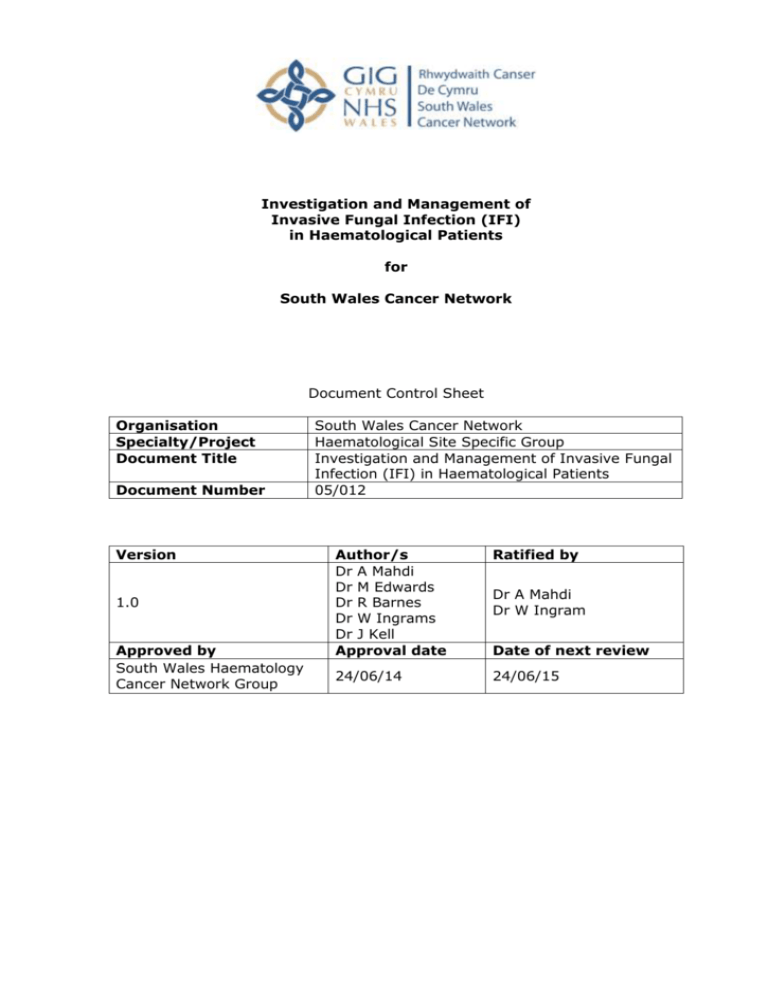
Investigation and Management of Invasive Fungal Infection (IFI) in Haematological Patients for South Wales Cancer Network Document Control Sheet Organisation Specialty/Project Document Title Document Number Version 1.0 Approved by South Wales Haematology Cancer Network Group South Wales Cancer Network Haematological Site Specific Group Investigation and Management of Invasive Fungal Infection (IFI) in Haematological Patients 05/012 Author/s Dr A Mahdi Dr M Edwards Dr R Barnes Dr W Ingrams Dr J Kell Approval date Ratified by 24/06/14 24/06/15 Dr A Mahdi Dr W Ingram Date of next review Investigation and Management of Invasive Fungal Infection (IFI) in Haematological Patients High Risk Patients: AML/ MDS undergoing remission-induction therapy and allogeneic bone marrow transplant recipients on GVHD prophylaxis \ Prophylaxis Screening High risk patients should receive fungal prophylaxis: Fluconazole 400mg od Weekly fungal PCR/ELISA for high risk patients on Fluconazole prophylaxis (weekly AmBisome (3mg/kg) in acute lymphoblastic leukaemia patients undergoing phase I induction) Patients on secondary mould-active prophylaxis (voriconazole, AmBisome or posaconazole) do NOT require aspergillosis PCR/ ELISA screening All other patients should only have fungal PCR/ ELISA if there is a clinical suspicion of IFI (see appendix 3.2 for interpretation) Suspicious clinical features (see appendix 4) Investigation of suspected IFI Request: Aspergillus PCR/ ELISA (if not undertaken), blood cultures, HRCT If localising signs: CT sinuses if suspected sinus infection and ENT review Lumbar puncture CT/ MRI head Sputum/ BAL Where possible tissue should be gained to confirm presence of fungal elements Define IFI (proven, probable, possible) using EORTC/MSG criteria (see appendix 6) Treatment indicated in cases of proven and probable Initiate with approval of consultant haematologist especially if empirical treatment (see appendix 6.1) Liaise with microbiology team First line: Voriconazole 400mg BD PO for 2 doses then 200mg BD PO If significant liver impairment: AmBisome 3mg/kg OD IV STOP screening fungal PCR/ ELISA whilst on active treatment Stopping treatment If CT normal or non-specific: Send ELISA after 12-14 days. Stop treatment if negative and resume screening, Anti-mould secondary prophylaxis Indicated for: Patients with previous proven/probable disease after discussion at MDT If CT suggestive of IFD Send ELISA after 14 days and weekly thereafter. Stop after 2 consecutive negatives. Discuss at MDT regarding need for ongoing secondary prophylaxis or resume screening Authors: A Mahdi, M Edwards, R Barnes, W Ingram, J Kell Approval: 27/6/14 Investigation and Management of Invasive Fungal Infections in Haematology Patients Protocol 1. Introduction Invasive fungal infections (IFI) present a unique group of opportunistic organisms in immunocompromised patients accounting for significant mortality and morbidity. There is a wide variation in the risk associated with patient groups and the treatment they receive. Candidaemia associated mortality is approximately 24% (Viscoli et al 1999) and invasive proven aspergillosis mortality at 3 months for matched unrelated donor allografts 84.6% (Morgan et al 2005). In addition, there is a huge financial burden in both the investigation and treatment of such patients hence a rational and targeted approach is imperative. Therefore, the diagnosis of IFI should be confirmed wherever possible (BCSH 2008). Authors: A Mahdi, M Edwards, R Barnes, W Ingram, J Kell Approval: 27/6/14 2. Risk factors High Risk Patients (Herbrecht et al 2012) Underlying Incidence of Identified specific patient and treatment-related risk factors condition invasive aspergillosis (%) Allogeneic 2.7–23 Delayed neutrophil Respiratory virus hematopoietic engraftment infections stem cells Secondary neutropenia Renal failure, Lymphocytopenia, Reduced-intensity monocytopenia conditioning regimen Purine analogues or Cord blood monoclonal antibodies T cell-depleted or CD34selected stem cell products History of invasive aspergillosis Unrelated or mismatched donor graft Iron overload Acute or chronic graft Advanced age versus host disease Donor toll-like receptor Corticosteroids, polymorphism CMV disease Acute myeloid 5–24 Neutropenia Advanced age leukemia Monocytopenia Iron overload chemotherapy Purine analogues Influenza H1N1 virus Monoclonal antibodies Lack of response to induction Acute 3.8 Lymphopenia lymphoblastic Corticosteroids leukemia Advanced age Intermediate Risk/ Low risk (Herbrecht et al 2012) Underlying Incidence of Identified specific patient and treatment-related risk factors condition invasive aspergillosis (%) Autologous 0.5–6 Neutropenia Lymphoproliferative hematopoietic malignancy as indication Purine analogues or stem cells for transplantation monoclonal antibodies Multiple 2–3 Neutropenia Advanced age myeloma Corticosteroids Non-Hodgkin’s 0.8 Corticosteroid Advanced age lymphoma Purine analogues or monoclonal antibodies Hodgkin 0.4 None identified lymphoma Authors: A Mahdi, M Edwards, R Barnes, W Ingram, J Kell Approval: 27/6/14 3. Prophylaxis In the context of allogeneic transplant patients, there is no difference in overall survival with fluconazole and voriconazole in the prevention of IFI (Wingard et al 2010). Patients at high risk of IFI should receive fluconazole 400mg OD PO. These include: 1. AML/ MDS patients undergoing remission-induction therapy 2. Allogeneic transplant patients from conditioning and receiving GVHD prophylaxis or treatment ALL patients undergoing induction chemotherapy should receive weekly AmBisome (3mg/kg IV) prophylaxis in light of the interaction of azoles and vincristine. Thereafter, fluconazole 400mg OD PO should be used. Patients with severe aplastic anaemia should be discussed at MDT and may be treated as high risk and screened or may receive mould active prophylaxis. Other patients should NOT receive prophylaxis unless there is a history of IFI although general risk factors should be taken into account in making this decision. 3.1 Screening for invasive aspergillosis The following groups of patients should have weekly aspergillus PCR/ ELISA screening: 1. AML/ MDS patients undergoing remission-induction therapy 2. Allogeneic transplant patients from conditioning and receiving GVHD prophylaxis or treatment Patients receiving active mould prophylaxis (voriconazole, AmBisome or posaconazole) or treatment should not undergo screening. Patients with suspected breakthrough infection should be investigated (see below). All other patients should only have fungal PCR/ ELISA testing if there is a neutopenic fever or clinical suspicion of IFI (see below). All biomarker tests requested from the haematology department in UHW will be reviewed on a weekly basis with input from microbiology and haematology teams (general and transplant). This occurs every Tuesday morning in the haematology day centre. For tests sent from other hospitals, discussion with the local microbiology department or the Mycology Regional Reference Unit (029 2074 4515) to aid interpretation and decision making is advised. It is the responsibility of the person requesting the test to ensure that it is appropriate. Authors: A Mahdi, M Edwards, R Barnes, W Ingram, J Kell Approval: 27/6/14 3.2 Interpretation of screening PCR and EIA negative: Invasive aspergillosis extremely unlikely empirical antifungal treatment not indicated Single positive EIA Index : >0.7: Request a repeat specimen. Single positive PCR: Request a repeat specimen. Single positive PCR, or a single positive GM index of ≥0.7 or two consecutive GM indices of 0.5-0.6 may indicate false positivity. It is not an indication for commencement of anti-fungal therapy in patients without clinical signs but should prompt repeat specimens and may lead to further investigation. Repeat PCR and/or EIA positives: Consider further investigations (CT/BAL) and anti-fungal treatment. Discuss at MDT. 4. Investigation of suspected IFI There should be a high index of suspicion of IFI when patients’ pyrexia fails to respond to broad spectrum antibacterials in the context of prolonged neutropenia and/or immunosuppression. Clinical features suggestive of IFI (BSCH 2008) Any new fever during prolonged, severe neutropenia or immunosuppression Fever resistant to broad spectrum antibacterial therapy while neutropenic Symptoms and signs of new, resistant or progressive lower respiratory tract infection, e.g. pleuritic pain, pleural rub Prolonged, severe lymphopenia in chronic graft versus host disease (GVHD) and immunosuppression Symptoms and signs of progressive upper respiratory tract infection Periorbital swelling Maxillary swelling and tenderness Palatal necrosis or perforation Focal neurological or meningeal irritation symptoms and signs with fever Unexplained mental changes with fever Papular or nodular skin lesions Intra-ocular signs of systemic fungal infection Authors: A Mahdi, M Edwards, R Barnes, W Ingram, J Kell Approval: 27/6/14 5. Diagnosis Clinical features suggestive of invasive fungal infection (IFI) warrant early and thorough investigation to yield microbiological data and early use of systemic antifungal therapy. The EORTC/MSG consensus group guidelines (2008) should be used in defining IFI. Proven Identification of fungal elements via Microscopic examination of sterile material, or Culture of sterile material or blood, or Serological analysis of CSF i.e. Cryptococcal antigen Probable (all 3 factors present) Host factor 1. Neutropenia, 2. Allogeneic stem cell transplant recipient, 3. Prolonged corticosteroid use, 4. Treatment with T cell immunosuppressants (e.g. cyclosporin, alemtuzumab) Clinical 1. Lower respiratory tract infection (Positive HRCT findings), 2. Sinonasal criteria infection (positive imaging, acute localised pain, extension from paranasal sinus across bony barriers), 3. CNS infection (focal lesions/ meningeal enhancement on imaging), 4. Disseminated candiasis (Bull’s eye lesions in liver/ spleen, progressive retinal exudates on ophthalmic examination) Mycological 1. Positive fungal PCR, 2. Positive galactomannan antigen (plasma, criteria serum, BAL, CSF) Possible (only host factors and clinical criterion met) In patients with suspected IFI, the following should be requested: Fungal PCR/ ELISA Blood cultures Urine cultures HRCT If localising signs: CT sinuses if suspected sinus infection and ENT review Lumbar puncture CT/ MRI head Sputum/ BAL 6. Treatment issues in IFI Treatment should be initiated after discussion with the microbiology team and haematology consultant. Cases of ‘proven’ and ‘probable’ IFD warrant treatment. Preemtive therapy based on screening results or targeted treatment based on postive results during fever or on the basis of clinical signs may be initiated after discussion of risk 6.1 Empirical treatment Empirical treatment is generally not recommended (BCSH 2008). However, in cases where no investigations (biomarkers/CT/BAL etc.) have been performed, treatment may be warranted after 96 hours of refractory fever while investigations (HRCT/Bronchoscopy and biomarkers) are pending. Empirical therapy should not be commenced until samples for biomarker testing have been taken. Authors: A Mahdi, M Edwards, R Barnes, W Ingram, J Kell Approval: 27/6/14 6.2 First line therapy In the absence of specific fungal elements: Voriconazole 400mg BD PO for 2 doses then 200mg BD PO; if cannot tolerate PO then 6mg/kg IV for 2 doses then 4mg/kg thereafter. Where there is significant liver dysfunction (i.e. bilirubin>50mg/dL or Child-Pugh class C), use AmBisome 3mg/kg OD IV. Give test dose if no previous exposure and monitor for signs of anaphylaxis. Treatment should be reviewed after 5-7 days. Liaise with microbiology if proven IFD for definite treatment. 6.3. Stopping treatment Where patients have completed a defined treatment course for IFI, the decision to start on nonactive mould prophylaxis should be made taking into account individual risk factors. The decision to stop treatment in these patients should be taken in the setting of an MDT approach with the microbiology and transplant haematology teams. Radiological findings should determine the next course of action. If CT normal or non-specific of IFD Send ELISA after 12-14 days therapy. Stop treatment if negative and resume screening. Total therapy would amount to 12 days. If CT suggestive of IFD Send ELISA after 14 days therapy and weekly thereafter. Stop after 2 consecutive negatives. Hence a minimum of 21 days of treatment. Discuss at MDT regarding need for ongoing secondary prophylaxis or resume screening. 6.4. Secondary prophylaxis Secondary prophylaxis is indicated for allogeneic bone marrow recipients with previous proven/probable IFD. Screening of fungal PCR/ ELISA is not indicated for these patients. Posaconaozole (200mg TDS PO) is currently licensed as secondary prophylaxis. An ECG should be undertaken on initiation as posaconazole can prolong the QTc interval. The decision to start secondary active mould prophylaxis (including agent used) should be taken in the setting of an MDT approach with the microbiology and transplant haematology teams. If secondary prophylaxis is stopped then biomarker screening should be resumed. Authors: A Mahdi, M Edwards, R Barnes, W Ingram, J Kell Approval: 27/6/14 References De Pauw, B, et al. "Revised definitions of invasive fungal disease from the European organization for research and treatment of cancer/invasive fungal infections cooperative group and the national institute of allergy and infectious diseases mycoses study group (EORTC/MSG) consensus group." Clinical Infectious Diseases 46.12 (2008): 1813-1821. Herbrecht, R, et al. "Risk stratification for invasive aspergillosis in immunocompromised patients." Annals of the New York Academy of Sciences 1272.1 (2012): 23-30. Marsh, J. C. W., et al. "Guidelines for the diagnosis and management of acquired aplastic anaemia." British journal of haematology 123.5 (2003): 782-801. Morgan J, Wannemuehler KA, Marr KA, Hadley S, Kontoyiannis DP, Walsh TJ, Fridkin SK, Pappas PG, Warnock DW. (2005) Medical Mycology, 43, S49-58. Prentice et al. ‘Guidelines on the management of invasive fungal infection during therapy for haematological malignancy’. British Committee for Standards in Haematology. 2008. Viscoli, C., et al. "Candidemia in cancer patients: a prospective, multicenter surveillance study by the Invasive Fungal Infection Group (IFIG) of the European Organization for Research and Treatment of Cancer (EORTC)." Clinical infectious diseases 28.5 (1999): 1071-1079. Wingard, J R., et al. "Randomized, double-blind trial of fluconazole versus voriconazole for prevention of invasive fungal infection after allogeneic hematopoietic cell transplantation." Blood 116.24 (2010): 5111-5118. Authors: A Mahdi, M Edwards, R Barnes, W Ingram, J Kell Approval: 27/6/14
